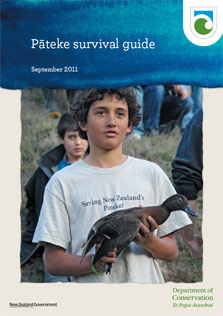Brown Teal Description
Just as its name implies, the Brown Teal is a small brown dabbling duck of teal-like size. For close to a century it was simply referred to as the Brown Duck.
In non-breeding plumage both male and female teal, and also juvenile Brown Teal, look alike. All have a distinctive whitish narrow ring around each eye, with their head, face and throat a mottled brown.

In breeding plumage the male will display a chestnut coloured breast, a greenish coloured head, and invariably display a distinctive, mallard-like, white stripe on each side of their flank. Some will display a white clerical neck band and some males tend to be more colourful than others, with a few occasionally resembling the spectacular colours of a Chestnut teal (Anas castanea) male.
Both sexes have a black iris, a green tending to black speculum, with a thin white wing-bar, and both have grey slate coloured legs and feet.
The male Brown Teal is slightly larger and heavier than the female, with the average weight being 620 – 700g for a male and 530 – 600g for a female; somewhat heavier and larger that the Grey teal (Anas gibberifrons) and approximately the same weight as the chestnut teal, although the shape of Brown Teal is quite different to each of these Australian species. Brown teal also have wings considerably shorter than the Australian teal.
The bill of Brown Teal is reminiscent of that of the NZ Shoveler (Anas ryhnchotis variegata) in that they have a very strong lamellae, which is ideal for sieving material for food and which is a major feeding method for Brown Teal. Possibly another unique feature of Brown Teal compared to other teal?
The only relatives of the fully flighted Brown Teal, which is a strong flier, are both the flightless Auckland Island Teal (Anas aucklandica) and the flightless Campbell Island Teal (Anas nesiotis); although the general behaviour and habitat requirements of Brown Teal are quite different to both these species.

All three species are very similar with their vocal cords, with males mainly uttering a muted bell-like whistle and the females a raucous growl.
The main breeding season for wild Brown Teal is from July to November, but in certain circumstances, that is, if the conditions are suitable, Brown Teal have been known to breed in every month of the year; a truly unique phenomenon.
The eggs of Brown Teal are cream-tan in colour and for a bird weighing only 500g a Brown Teal egg is by far the largest of all teal eggs, equivalent to a massive eleven percent of the female’s weight and measuring a unique teal sized egg of 58 x 43mm. The clutch size rarely exceeds five to six eggs and the incubation period is 27-30 days. Juveniles fledge at 55 days.
In the wild two clutches in a breeding season have been regularly recorded from one pair of teal and this is undoubtedly one of the reasons for moult irregularities. There is also considerable inconsistency with the moulting period for both wild and captive Brown Teal; many pairs will moult immediately after rearing a brood, but others are much slower.

